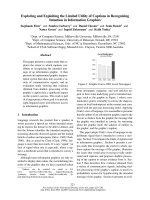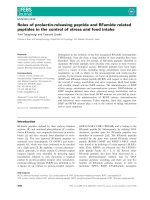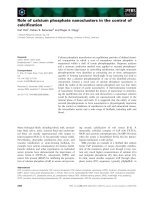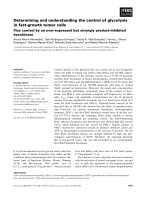Exploiting the inherent coordination of central pattern generator in the control of humanoid robot walking
Bạn đang xem bản rút gọn của tài liệu. Xem và tải ngay bản đầy đủ của tài liệu tại đây (3.65 MB, 177 trang )
EXPLOITING THE INHERENT COORDINATION
OF CENTRAL PATTERN GENERATOR IN THE
CONTROL OF HUMANOID ROBOT WALKING
HUANG WEIWEI
NATIONAL UNIVERSITY OF SINGAPORE
2010
Exploiting the Inherent Coordination of
Central Pattern Generator in the Control of
Humanoid Robot Walking
HUANG WEIWEI
(B.Eng, USTC)
A THESIS SUBMITTED
FOR THE DEGREE OF DOCTOR OF PHILOSOPHY
DEPARTMENT OF MECHANICAL ENGINEERING
NATIONAL UNIVERSITY OF SINGAPORE
2010
i
Acknowledgments
First and foremost, I would like to express my most sincere gratitude to my supervisor,
Assoc. Prof. Chew Chee-Meng, for his valuable supervision, incisive insight, enthusi-
astic encouragements and personal concerns in both academically and socially. These
five years study has been fun and rewarding due to the freedom, support, and respect
Chew has given to me.
I want to thank my supervisor Assoc. Prof. Hong Geok-Soon, who has given me con-
structive suggestions for this research.
I wish to specifically thank all the thesis reviewers and oral deference examiners. Your
comments enlighten me to a deeper lever of understanding about my research work.
Thanks to all the thesis proofreaders: Albertus, James, Samuel, Huan and Chanaka who
helped to point out many errors in the thesis.
My gratitude is also extended to all the members of the Mechatronics and Control Lab
who have supported me and become friends over the years.
Finally, my deepest thanks go to my parents, my family, and specially to my wife Went-
ing for their great support during my study.
NATIONAL UNIVERSITY OF SINGAPORE SINGAPORE
ii
Table of Contents
Acknowledgments i
Summary vii
List of Tables ix
List of Figures xvii
Acronyms xviii
Nomenclature xix
1 Introduction 1
1.1 Background 1
1.2 Motivation 5
1.3 Objectives and Scope 6
NATIONAL UNIVERSITY OF SINGAPORE SINGAPORE
TABLE OF CONTENTS iii
1.4 Thesis Contribution 9
1.5 Simulation Tools 10
1.6 Experiment Robot 10
1.7 Organization of the Thesis 12
2 Literature Review 14
2.1 Overview of the Powered Humanoid Robot 14
2.2 Overview of the Walking Algorithm 16
2.3 CPG Based Approach 19
2.3.1 Model Design 20
2.3.2 Applications in Robotics 22
2.3.3 Coordination 23
2.4 Summary 25
3 Coordination between Oscillators 28
3.1 Introduction 28
3.2 Neural Oscillator Description 31
3.2.1 Neural Oscillator Model 31
3.2.2 Entrainment Property 34
NATIONAL UNIVERSITY OF SINGAPORE SINGAPORE
TABLE OF CONTENTS iv
3.3 Coordination between Neural Oscillators 35
3.3.1 Phase Adjustment 35
3.3.2 Closed Loop Phase Adjustment 38
3.3.3 Coordination between Oscillators 44
3.4 Implementation in 2D Walking Control 50
3.4.1 Control Architecture 50
3.4.2 Simulation Results 55
3.5 Summary 60
4 Coordination between CPG and Sensory Feedback 62
4.1 Introduction 62
4.2 Sensory Inputs to the Oscillator 64
4.3 Stepping Motion Controlled by CPG 68
4.3.1 Proposed Stepping Motion Description 68
4.3.2 Arrangement of Oscillator and Sensory Feedback 70
4.3.3 Discrete Time Oscillator Model 75
4.3.4 Simulation Experiments 76
4.3.5 Perturbation Test I 89
4.3.6 Perturbation Test II 90
NATIONAL UNIVERSITY OF SINGAPORE SINGAPORE
TABLE OF CONTENTS v
4.3.7 Forward Walking 98
4.4 Summary 101
5 Real Implementation on ASLAN 104
5.1 Hardware Platform 105
5.1.1 ASLAN Overview 105
5.1.2 Control System 107
5.2 Oscillator Arrangement 109
5.3 CPG Based Stepping Motion 111
5.4 CPG Based Level Ground Walking 113
5.5 Summary 117
6 Conclusion 119
6.1 Summary of Research Contribution 121
6.2 Directions for Future Work 123
Bibliography 125
Appendix I: ASLAN Description 135
A.1 History 135
A.2 Mechanical Design 136
NATIONAL UNIVERSITY OF SINGAPORE SINGAPORE
TABLE OF CONTENTS vi
A.2.1 Head and Trunk Design 136
A.2.2 Arm Design 138
A.2.3 Waist Design 139
A.2.4 Leg Design 140
A.2.5 Foot Design 140
A.3 Control System 143
A.3.1 Sensors 143
A.3.2 Drive Unit 144
A.3.3 Programming Environment 145
Appendix II: Conditions for Limit Cycle Behavior 147
Appendix III: Amplitude of Neural Oscillator 151
Author’s Publications 154
NATIONAL UNIVERSITY OF SINGAPORE SINGAPORE
vii
Abstract
In this work, a bio-inspired central pattern generator (CPG) controller is developed to
achieve an adaptive and robust walking control. CPG is an approach which tries to
model the local control system of bipedal animals through a neural oscillator based
network structure. This work includes designing a coordination connection between os-
cillators in the CPG; classifying the sensory feedback to the CPG; building a humanoid
robot for the real implementation and controlling the robot with the proposed CPG con-
troller.
Coordination among oscillators in the CPG is critical and important for the adaptive
walking control. A CPG is usually composed of many coupled oscillators which output
rhythm trajectories. These oscillators need to coordinate with other oscillators when
there are external perturbations. By using the entrainment property of the neural oscil-
lator, we develop a coordination connection between oscillators. With this connection,
the main oscillator can adjust the phase of other oscillators for the coordination purpose.
With this coordination connection, a CPG controller is developed to control the walking
of a 2D bipedal robot. The simulation results show that the coordination connection en-
ables the CPG controller to maintain the phase relationship among oscillators after the
NATIONAL UNIVERSITY OF SINGAPORE SINGAPORE
SUMMARY
viii
push applied on the robot. This helps the robot to maintain the stability after the pushes
are applied.
Another topic studied in the thesis is sensory feedback classification. The sensory feed-
backs modulate the output of the oscillator and enable an adaptive behavior to the envi-
ronment changes. Based on the way of modification to the oscillator output, we classify
the sensory inputs into three types: inhibition input, triggering input and modification
input. The purpose of this classification is to make the feedback design easier. With
these three types of sensory inputs, the CPG controller can generate the reference tra-
jectories for the 3D dynamic walking. In the simulation, the CPG controller is used
to control a 3D stepping motion first. The sensory feedbacks modify the output of the
oscillators to balance the robot motion when pushes are applied. After the stepping ex-
periments, a stable 3D level ground walking is achieved by adding the forward motion
trajectories.
To further test the controller, we implement it to control our physical humanoid robot
NUSBIP-III ASLAN. ASLAN is a newly developed robot which serves as a platform
to test different walking algorithms. It is a fully autonomous humanoid robot which has
an approximate height of 120cm and an approximate weight of 60kg. It has 23 DoFs
it total with two arms, two legs and one head. We have successfully implemented the
CPG controller on ASLAN for stepping and walking motion. The robot shows a stable
walking behavior with the CPG controller.
NATIONAL UNIVERSITY OF SINGAPORE SINGAPORE
ix
List of Tables
3.1 The specifications of simulation model 52
5.1 Gear sizes, reduction ratios and joint working ranges HD: harmonic
drive; PB: pulley belt; GH: gear head; BM: brush motor; BLM: brush-
less motor 107
5.2 The values of oscillators’parameters in CPG controller 111
NATIONAL UNIVERSITY OF SINGAPORE SINGAPORE
x
List of Figures
1.1 Applications of humanoid research; a:robot leg for disable people [2];
b(1,2):human friendly robot Actroid [1] DER2and HRP-4 [4]; c(1-3):
working robots HRP-2 [4], HRP-3 [4] and ASIMO [3]; d(1-4): enter-
tainment robots: Toyota robot [8], QRIO [7], Murata boy [5] and HRP-2
[4] 3
1.2 Yobotics simulation construction set GUI window 11
1.3 Webots simulation construction set GUI window 11
1.4 Humanoid robot ASLAN in SolidWorks design and actual robot 12
3.1 A hierarchical CPG structure with coordination connection between os-
cillators. 31
3.2 Scheme of Matsuoka’s neural oscillator model; white and black cycles
represent excitation and inhibition, respectively 33
3.3 Properties of neural oscillator; top: entrainment property, bottom: sup-
pression of oscillator by a large constant input 35
NATIONAL UNIVERSITY OF SINGAPORE SINGAPORE
LIST OF FIGURES xi
3.4 A lookup table that mapping the phase of the oscillator to the neuron
states and oscillator’s output in a single oscillating cycle without any
external input. A, B, C, D are four example of lookup table where a
phase value is related with an unique neuron states value. 37
3.5 Example of phase modification by changing the neuron state’s value;
upper figure: direct change the neuron state to the desired phase value;
bottom figure: a smooth change of neuron state to the desired phase value. 38
3.6 Closed loop structure for reference input. Black dot indicates an inhibi-
tion connection; hollow dot indicates an excitation connection. 40
3.7 Example of oscillator following a reference input where K equals to 0
before 2s and become nonzero after 2 s. 40
3.8 A block diagram of coordination process between oscillators. 45
3.9 Examples of phase relationship between periodic signals. upper figure:
sinusoidal wave with same frequency but different initial phase; middle
figure: the frequency of signal 3 is 1.5 times higher than signal 1; bottom
figure: the frequency of signal 4 is twice of signal 1. 46
3.10 Example of two oscillators output without coordination after an external
disturbance in the form of nonzero input 50
3.11 Example of two oscillators output with coordination after an external
disturbance in the form of nonzero input 51
NATIONAL UNIVERSITY OF SINGAPORE SINGAPORE
LIST OF FIGURES xii
3.12 Oscillator arrangement and sensory feedback of the CPG structure on
the robot 52
3.13 Reference Hip
x
trajectory. L
s
: left support; R
s
: right support 53
3.14 Reference trajectory of stance hip and swing foot 53
3.15 Swing leg retraction 55
3.16 Snapshots of forward walking in simulation 57
3.17 Os
hipx,Os footx and Os footz1+Os footz2 outputs and sensory feed-
backs in the forward walking with external disturbance 58
3.18 Stick diagram of walking with external disturbance 58
3.19 Os
hipx,Os footx and Os footz1+Os footz2 outputs and sensory feed-
backs in the forward walking without coordination 59
3.20 Body velocity plot when walking step length is changed 59
3.21 Body velocity plot when walking frequency (walking period) is changed 60
4.1 The diagram of how sensory input affects the output of the oscillator,
u
o
1(2)
and v
o
1(2)
are state value for the desired phase 67
4.2 The cycle of marching on the spot 69
4.3 The state transition diagram between double supporting phase and sin-
gle supporting phase 71
4.4 The arrangement of the oscillators for stepping motion; only coordina-
tion connection between oscillators (C
sg) are shown in the figure . . . 72
NATIONAL UNIVERSITY OF SINGAPORE SINGAPORE
LIST OF FIGURES xiii
4.5 The sensory input to the oscillator; S i, S t and S p are the inhibition
input, triggering input and parameter modification input which show
how the the sensory feedback input to the oscillators 74
4.6 Schematic diagram of the simulated robot 77
4.7 The output of swing foot oscillator in half walking cycle 79
4.8 An example of Foot
z output adjusted by touching down signal; the
trajectories shown in circle is the smooth trajectory which make the ref-
erence trajectories return back to 0 80
4.9 Simulation data: the reference trajectories generated by oscillators, the
body velocity, the ground reaction force on both feet and the swing time
in each step (from top to bottom); the foot trajectories are activated by
the triggering inputs 82
4.10 Simulation data: the limit cycle behavior of body hip position and ve-
locity in y direction (top); a plot of ZMP trajectory (bottom) 83
4.11 Additional phase resetting signal during the stepping motion cycle. . . . 84
4.12 Simulation data: the reference trajectories generated by oscillators, the
body velocity, the ground reaction force on both feet and the swing time
in each step (from top to bottom); the controller is adjusted by two phase
resetting signal. 85
4.13 Simulation data: the limit cycle behavior of body hip position and ve-
locity in y direction (top); a plot of CoP trajectory (bottom) 86
NATIONAL UNIVERSITY OF SINGAPORE SINGAPORE
LIST OF FIGURES xiv
4.14 Simulation data: Without double supporting phase, the foot touches
much earlier than the desired time (top2&3) 87
4.15 Simulation data: the stepping motion does not approach to a limit cy-
cle (top); the CoP location in single support is always on the boundary
(bottom) 88
4.16 Simulation data: a compare of swing period with different CoP trigger-
ing value: CoP=0 (top), CoP=0.01(middle), CoP=0.02 (bottom) 89
4.17 An example of push applied on the robot. 90
4.18 Simulation data: the limit cycle behavior of body motion, the body ve-
locity in y direction, CoP trajectory and swing period of both leg (from
top to bottom); The circle in the subplot of body velocity shows the ve-
locity changes because of the push; the dashed circle in the subplot of
swing period shows the adjustment of swing period during the push . . 91
4.19 Simulation data: a bigger force applied on the robot; the CoP location is
almost at boundary of the foot because of the force (circled); the swing
period converge back to the normal walking pattern after the perturba-
tion (bottom) 92
4.20 The arrangement of oscillators with additional motions when a push is
applied; the oscillators in side the dashed line are only activated by the
triggering input, the coordination adjustment is also connected when
these oscillators are activated 94
NATIONAL UNIVERSITY OF SINGAPORE SINGAPORE
LIST OF FIGURES xv
4.21 The push is applied on the supporting side. 95
4.22 Simulation data: the reference output of the oscillators’ trajectories,
body velocity in y direction and ground reaction force on both feet (from
top to bottom); the body velocity changes when the push is applied as
shown in the cycle of body velocity subplot; the velocity change triggers
the activity of side step motion as shown in subplot of additional move
of hip and both feet 96
4.23 Simulation data: the limit cycle behavior of body motion, the body ve-
locity in y direction, ZMP trajectory and swing period of both leg (from
top to bottom); the two circle in the subplot of limit cycle trajectory
shows two stable motion before and after push 97
4.24 The arrangement of oscillators for forward walking; oscillators Os
hipx v,
Os
lfootx v and Os rfootx v provide the trajectories of forward motion 99
4.25 Simulation data: the reference trajectories generated by oscillators and
the corresponding ground reaction force on both leg; the body hip tra-
jectory is calculated by the accumulation of the body hip velocity in x
direction; the swing period converge to a similar value in the forward
walking (bottom) 100
4.26 A stick diagram (in sagittal plane) of forward walking 101
5.1 Photograph and technical layout of the 23-DoF humanoid walking robot
ASLAN 105
NATIONAL UNIVERSITY OF SINGAPORE SINGAPORE
LIST OF FIGURES xvi
5.2 Kinematic structure of ASLAN 106
5.3 Control structure of ASLAN 108
5.4 The arrangement of oscillators to control the walking of ASLAN 109
5.5 System architecture of CPG based walking control of ASLAN 112
5.6 Experimental data: the reference trajectories generated by the oscilla-
tors, the ground reaction force on both feet and the swing time in each
step 114
5.7 Experimental data: the reference joint trajectories calculated by inverse
kinematics, the red circle indicate the modification of hip roll joint by
the compensator. 115
5.8 Snapshots of the stepping motion by ASLAN 115
5.9 Experimental data: the reference trajectories generated by the oscilla-
tors, the ground reaction force on both feet and the swing time in each
step 116
5.10 Snapshots of one cycle of level ground walking 117
A.1 The design of ASLAN in SolidWorks. 137
A.2 The head design of ASLAN. 137
A.3 The trunk design of ASLAN. 138
A.4 The arm design of ASLAN. 139
A.5 The waist design of ASLAN. 140
NATIONAL UNIVERSITY OF SINGAPORE SINGAPORE
LIST OF FIGURES xvii
A.6 The leg design of ASLAN. 141
A.7 The foot design of ASLAN. 142
A.8 The absolute encoder of ASLAN (1):MAE3, (2):wire sensor 143
A.9 Other sensors of ASLAN (1): accelerometer, (2) gyro, (3) force/torque
sensor 144
A.10 The amplifier of the ASLAN and an example of position and velocity
tracking 144
A.11 The diagram of communication between main program and ELMO driver
program 146
C.1 The output of the neuron in u1-u2 plane. 152
NATIONAL UNIVERSITY OF SINGAPORE SINGAPORE
xviii
Acronyms
BLM Blushless Motor
BM Blush Motor
CMAC Cerebellar model articulation controller
CoM Center of mass
CoP Center of pressure
CPG Central pattern generator
DoF Degree of freedom
GF Ground reaction force
GH Gear Head
HD Harmonic Drive
IK Inverse kinematics
LIPM Linear inverted pendulum model
PB Pulley Belt
PWM Pulse Width Modulation
ZMP Zero moment point
4R
K Fourth order Runge-Kutta equation
NATIONAL UNIVERSITY OF SINGAPORE SINGAPORE
xix
Nomenclature
a Strength of inhibition connection between neurons
Ankle
l(r)
r(p)
Angle value of left(right) ankle roll(pitch) joint
Arm
l(r)
y(r,p)
Angle value of left(right) arm yaw(roll, pitch) joint
β
Parameter that indicates the effect of adaptation
c Constant stimulus to the oscillator
E
in
External input to the neuron
Elbow
l(r)
p
Angle value of left(right) elbow pitch joint
Hip
l(r)
y(r,p)
Angle value of left(right) hip yaw(roll, pitch) joint
Hipx(y)
v The actual hip velocity in x(y) direction in the simulation
H
CoM
Height of center of mass
lif t
s a variable which trigger the activity of foot lifting
Knee
l(r)
p
Angle value of left(right) knee pitch joint
Neck
p(r)
Angle value of neck pitch(roll) joint
NATIONAL UNIVERSITY OF SINGAPORE SINGAPORE
NOMENCLATURE
xx
Os hipx(y) Oscillator which gives reference trajectory for hip in x(y) di-
rection
Os
hipx v Oscillator which gives reference velocity trajectory for hip in
x direction
Os
hipx(y)v ad Oscillator which gives additional motion trajectory for hip in
x(y) direction when a strong push is applied
Os
r(l) footx(y, z) Oscillator which gives reference trajectory for right(left) foot
in x(y,z) direction
Os
r(l) footx v Oscillator which gives reference velocity trajectory for
right(left) foot in x direction
Os
r(l) footx(y)v ad Oscillator which gives additional motion trajectory for
right(left) foot in x(y) direction when a strong push is applied
τ
1(2)
Time constant of neuron 1(2)
u
1(2)
State of the neuron 1(2)
v
1(2)
State of neural adaptation 1(2)
W rist
l(r)
r(p)
Angle value of left(right) wrist roll(pitch) joint
x(y)
ZMP
ZMP location in x(y) direction
NATIONAL UNIVERSITY OF SINGAPORE SINGAPORE
1
Chapter 1
Introduction
1.1 Background
A humanoid robot working with human in human environment is the dream of re-
searchers in humanoid robot area. Human environment is especially designed for human
to live and work, while humanoid robot is a robot that has similar physical characteristic
with human. Therefore, this kind of robot has an advantage to operate in human envi-
ronment and avoids the need to alter the environment for the robots. Humanoid robot
and people could potentially collaborate with each another in the same working place
using the same tools. In addition, compared with other kinds of robots, a humanoid
robot has a smaller foot print and some mobility advantages in terms of walking up and
down stairs. All these advantages make humanoid research an important area among all
robotics research works.
NATIONAL UNIVERSITY OF SINGAPORE SINGAPORE
1.1 Background 2
Generally, the applications of humanoid robot can be divided into four areas. First,
humanoid robot have been developed as a test-bed for a better understanding of human.
This understanding can aid the development of better leg prostheses and help people
who lose their leg to walk again as shown in Fig. 1.1 a. Second, humanoid robot
can be a team worker with us. Human tools match human dexterity while humanoid
robot can potentially take advantage of these same accommodations. Fig. 1.1 c1 and
c2 show examples where humanoid robots use different types of tool to work in human
environment. Humanoid robot has a similar mobility pattern as human which enable
it to move in human environment freely. In Fig. 1.1 c3, ASIMO walks down from a
staircase which is a common in the human environment. Third, humanoid robot can be
used to provide assistance for children and elder care. Humanoid robot always has a
human-like look (examples can be seen in Fig. 1.1 b1 and b2). Children or elder will
feel more comfortable when facing a humanoid robot instead of other types of robot.
Also, humanoid robots are inherently appropriate for the entertainment of humans. For
example, many traditional forms of entertainment, such as playing music and dancing,
require a similar structure of human as shown in Fig. 1.1 d1, d2, d3 and d4.
In humanoid research, walking is one of the most important and challenging area to
study. Bipedal walking is the key advantage of humanoid robot compared with wheel
robots. Currently, great effort has been put in this area to enable the humanoid robot to
have the similar mobility as human. Until now, bipedal walking is still a challenging
area to achieve human-like walking motion. The followings are some of the reasons.
First, walking is a highly non-linear and discontinuous system. To model and analyze it
NATIONAL UNIVERSITY OF SINGAPORE SINGAPORE
1.1 Background 3
Figure 1.1: Applications of humanoid research; a:robot leg for disable people [2];
b(1,2):human friendly robot Actroid [1] DER2and HRP-4 [4]; c(1-3): working robots
HRP-2 [4], HRP-3 [4] and ASIMO [3]; d(1-4): entertainment robots: Toyota robot [8],
QRIO [7], Murata boy [5] and HRP-2 [4]
NATIONAL UNIVERSITY OF SINGAPORE SINGAPORE









